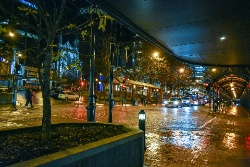New plan for Managed Aquifer Recharge
New plan for Managed Aquifer Recharge
El Nino
weather predictions and tight timeframes mean Council will
delay lodging consents for a Managed Aquifer Recharge (MAR)
trial in the Makauri Aquifer.
In a report to the Environmental Policy and Regulations Committee, shared services science manager Lois Easton says forecasts predict lower than normal rainfall which means it’s very unlikely there’ll be any surplus water from the Mangapoike Dam for the trial next winter.
The proposed trial is to investigate a MAR as one of the solutions to managing declining water levels in the Makauri Aquifer.
The trial proposes to inject high-quality (drinking water standard) surplus water from the Mangapoike Dam into the Aquifer. The Waipaoa River would be investigated as a long-term water source if the trial was successful.
“We’re taking this opportunity to look more closely at the potential to use the river water for the trial instead,” says Ms Easton.
“But we need the next four months to investigate it thoroughly.”
Technical work to date has looked at water to be taken from the dams due to the high quality of this water.
“So, first we need to have a good understanding of the quality of the river water and further consultation with the community and iwi,
“We also need to be able to provide appropriate treatment for the water to get it close to the standard of the Managapoike dam water.”
Council will need to source additional funding for the additional technical work and additional filtration and treatment if the river water is used.
“Water sourced from the Waipaoa treatment plant has been assessed and would be suitable, but there is a very high cost associated in using this plant,” says Ms Easton.
“However we’re doing some more research now on a less expensive option - sourcing water from infiltration chambers installed under the bed of the river.”
“Infiltration chambers abstract water through a bed of natural sands and gravels near the bank of the river.
“We think the samples from the infiltration chambers are likely to be similar to treated water, but this needs to be confirmed.”
Samples of water collected from upstream of the Waipaoa plant results have shown no detectable levels of agrichemicals.
“We’re working with the landowners to start sampling privately owned infiltration chambers.”
“We need to know how the water from the river varies from day to day, depending on flow conditions and the presence of sediment in the water.
“We’ll be assessing if more filtration and treatment is required to remove the risk of physical clogging, bacteriological clogging and also as with the Mangapoike water, we’ll be identifying the potential for chemical clogging caused by geochemical reactions as well.”
Communication with stakeholders and the community will also continue.
“The feedback we’ve received so far supports using a source of water that is closer to the natural recharge water for the Makauri aquifer.
“The Waipaoa River is one of main natural sources of the Makauri Aquifer water.”
Given the new timeline, consents for a MAR trial would be notified in autumn 2016 for the public to make submissions.
ENDS


 Gordon Campbell: On The Hamas Ceasefire Offer, And Mark Mitchell’s Incompetence
Gordon Campbell: On The Hamas Ceasefire Offer, And Mark Mitchell’s Incompetence Wellington Office of the Mayor: Mayor Responds To Housing Minister’s District Plan Decision
Wellington Office of the Mayor: Mayor Responds To Housing Minister’s District Plan Decision Stats NZ: Have Your Say On Modernising The Census
Stats NZ: Have Your Say On Modernising The Census NZ Government: Therapeutic Products Act To Be Repealed
NZ Government: Therapeutic Products Act To Be Repealed The Treasury: Interim Financial Statements Of The Government For Nine Months Ended 31-3-2024
The Treasury: Interim Financial Statements Of The Government For Nine Months Ended 31-3-2024  Government: New Zealand Sign Language Week An Opportunity For Anyone To Sign
Government: New Zealand Sign Language Week An Opportunity For Anyone To Sign ACT New Zealand: Investment In Prisons Delivers On ACT Commitment
ACT New Zealand: Investment In Prisons Delivers On ACT Commitment


